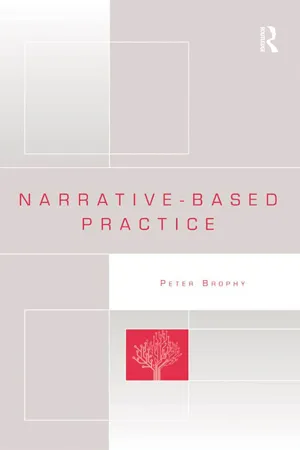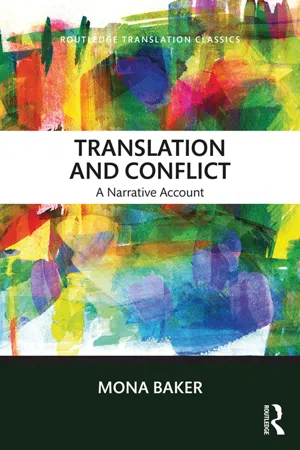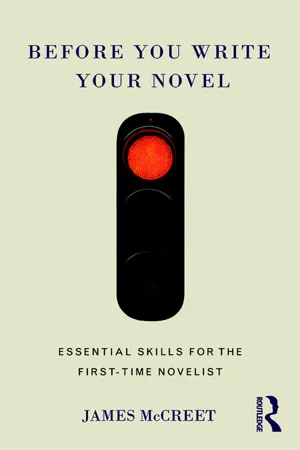Narrative Mode
Narrative mode refers to the method or style through which a story is presented to the reader. It encompasses various techniques such as first-person narration, third-person omniscient, and second-person narration. The narrative mode chosen by an author can significantly impact the reader's experience and understanding of the story.
7 Key excerpts on "Narrative Mode"
- eBook - ePub
- Peter Brophy(Author)
- 2016(Publication Date)
- Routledge(Publisher)
...In organisational settings, this can be an important way to achieve relevance. Style Narrative style refers to the way in which the narrative is presented. It includes point of view (considered further below), but also refers to the manner in which the story is told. For example, a newspaper report could be written in short, staccato phrases using contemporary jargon and references, or in longer, complex sentences perhaps with subclauses and explanations in parentheses using formal terminology. The latter would be perceived as a more ‘academic’ style and perhaps treated with more gravitas. The former would be more immediate, grabbing the attention. However, the two would not necessarily convey the same meaning, even to the same listener because style affects what is perceived. The way in which concepts are connected is also critical in conveying meaning, as Winterowd illustrates in the following observation: Take the two propositions The Lone Ranger rode a horse and The horse saved his life and combine them thus: The Long Ranger rode a horse that saved his life. The result is that one preserves the meaning of each proposition and creates their new, relational meaning.. Nor is the creation of meaning through embedding a trivial quality, but rather one of the great creative powers that the language confers upon its users: the power to express relationships through a finite series of recursive devices. (Winterowd 1975: 29) Point of View The point of view of a narrative refers to the standpoint or standpoints of the narrators, not to an opinion which they take – it sometimes referred to as the narratives ‘focus’ or ‘angle’: Like the camera in a film, the perspective of a narrative is always located somewhere, up above events, in amongst them, or behind the eyes of one or more of the characters involved. Like the film camera, the narrative voice can move around from one point of view to another, often shifting undetectably from outside to inside views...
- eBook - ePub
- Horst Ruthrof(Author)
- 2016(Publication Date)
- Routledge(Publisher)
...Chapter 3 Narrative language THE CONCRETE DATUM ‘Narrative,’ Michel Butor tells us, ‘is a phenomenon which extends considerably beyond the scope of literature; it is one of the essential constituents of our understanding of reality. From the time we begin to under stand language until our death, we are perpetually surrounded by narratives, first of all in our family, then at school, then-through our encounter with people and reading.’ (1) An even wider conception of narrative is offered by Barbara Hardy in ‘Towards a Poetics of Fiction: An Approach Through Narrative’, the focus of which is on ‘the qualities which fictional narrative shares with the inner and outer story telling that plays a major role in our sleeping and waking lives.’ And her paper makes the further claim that ‘we dream in narrative, daydream in narrative, remember, anticipate, hope, despair, believe, doubt, plan, revise, criticize, construct, gossip, learn, hate, and love by narrative.’ (2) This widens the discussion about narrative considerably, and I would like to specify some of these issues by first distinguishing ‘narrative’ as a non-literary or literary unit, a closed form, from ‘Narrative Mode’ as the predominant mode of presentation in narratives as well as in the non-formal inner and outer streams of story telling. As a second qualification, I should point out that there are also non-Narrative Modes in our mental lives. Do we not some-times slip into the role of a second self in order to defeat the opponent of a past real verbal contest by employing a superior strategy a posteriori? An inner drama is acted out in which we not simply sympathize or try to identify with one of the contestants but are the protagonist. Or, our stream of thought may take on an attitude of praying, total admiration, fear, triumph, or resignation in which the chanting I, the addressed object and the process of addressing appear to melt into one homogeneous whole...
- eBook - ePub
Researching Interpretive Talk Around Literary Narrative Texts
Shared Novel Reading
- John Gordon(Author)
- 2020(Publication Date)
- Routledge(Publisher)
...The genres of science fiction, historical narrative, detective story and social commentary span each medium. The subtle possibilities of narration from the perspective of a narrator offer the reader myriad opportunities for subjective response, from empathy through circumspection to credulity and evaluation. In considering how narrators frame their stories and in judging the veracity of their version of events, readers of novels enter into ontological and epistemological reflection not simply relative to the narrator’s expression in the text but also as they articulate their own perception. The novel thus constitutes a powerful educational device where students of literature enter such a dialogue: each novel offers a sounding board for exploring and articulating what it means to say, to know and to be. Narrative voice in the novel often takes a form akin to the mundane (in the sense of daily, not pejoratively) expressions of our lives, as we recount experiences and attempt to convey to others our subjectivity in relation to their own, and as our subjectivity enters the public sphere in verbal anecdote, gossip and explanation. Where novelists such as Thackeray and Dickens deploy omniscient narration, or where Henry James gives us access to the point of view of individual characters, we can attempt nuanced thinking about what it means to be someone else. The work of later novelists makes us acutely aware of the difficulties of conveying experience in language and narrative form, as in the work of Woolf, Joyce and Faulkner and their use ‘ stream of consciousness’. In their innovations these writers and many since have drawn our attention to the formulaic nature of conventional narrative forms and their construction. 3.3 Novels in Education The persistent study of novels in formal education may seem bizarre in an era where the novel is sometimes considered a dying or ailing form, the form no more than a ‘tissue of signs’ (Barthes, 1977, p. 146)...
- eBook - ePub
Narrative Form
Revised and Expanded Second Edition
- Suzanne Keen(Author)
- 2015(Publication Date)
- Palgrave Macmillan(Publisher)
...A modest level of reference to films acknowledges narratives in other media. That said, Narrative Form is located squarely in the field of literary studies, where the study of narrative has been going on for nearly a century. Familiarity with the terms and techniques commonly used in literary studies should permit the venturesome to enter interdisciplinary conversations confident of their ability to identify and describe the aspects of narrative that interest them. Even if an advanced student has no deep interest in narrative form, understanding the claims of narrative theory can still be useful. Narrative theory provides an extremely detailed vocabulary for the description of the component parts and various functions of narrative, but only a few advanced students will go on as narratologists. Many will be drawn to narrative literature, but will find contextual, thematic, or other theoretical approaches more immediately compelling. The approach to narrative form that I take in this handbook emphasizes the craft of fiction, and honors the makers and feigners who shape words to build story worlds in the minds of readers. It is my hope that advanced students who are drawn to narrative simply because they love to read will find the description of the narrative artist’s tool-kit of interest. In the process of reading this book, advanced students will acquire tools of their own for making critical distinctions and clarifying their observations about a writer’s craft. It is true that many critics are skeptical of the underlying assumption of formalist analysis, and that others shrink from anything that sounds like theory at all. I believe that the evidence of contemporary writing suggests that formal choices still matter to the makers of fiction...
- eBook - ePub
Translation and Conflict
A narrative account
- Mona Baker(Author)
- 2018(Publication Date)
- Routledge(Publisher)
...2 Introducing narrative theory The notion of narrative has attracted much attention in a wide range of disciplines, and has accordingly been defined in a variety of ways. This chapter will draw primarily on social and communication theory to elaborate a definition of narrative that is particularly suited to investigating the way in which translators and interpreters function in situations of conflict. I start with an overview of the status and effects of narrativity, including its relationship to genres, science, categories, fact and fiction, and conclude with a discussion of the political import of narratives and the way in which narrative both reproduces existing power structures and provides a means of contesting them. 2.1 The status and effects of narrativity Many scholars, especially in literary studies and linguistics, tend to treat narrative as an optional mode of communication, often contrasting it with argumentation or exposition. Approaches that treat narrative as an optional mode tend to focus on the internal structure of orally delivered or literary narratives – in terms of phases, episodes and plots, for instance – and to stress the advantages of using narrative, rather than other modes of communication, to secure the audience’s commitment and involvement. The best and most influential example of this tradition is Labov. A very brief summary of his approach might help clarify important differences between literary and linguistic approaches to narrative and the broadly sociological approach adopted in this book. Labov defines narrative as ‘ one method of recapitulating past experience by matching a verbal sequence of clauses to the sequence of events which (it is inferred) actually occurred’ (1972: 359–60; emphasis added), and what he calls a ‘ minimal narrative ’ as ‘a sequence of two clauses which are temporally ordered ’ (1972: 360; emphasis in original)...
- eBook - ePub
Before You Write Your Novel
Essential Skills for the First-time Novelist
- James McCreet(Author)
- 2016(Publication Date)
- Routledge(Publisher)
...It’s your responsibility as the writer to set the tone, create the atmosphere and the world of your text, and maintain it without flaw or contradiction. An inconsistent narrative style is like a fake accent – once you start to hear the dodgy vowels, it’s game over. The illusion is broken. There are advantages and disadvantages to every narrative approach. Some of the narrative approaches we might look at are: • Authorial perspective and voice • Character perspective and voice • Subject address (person) • Tense. Authorial perspective and voice How visible are you as the author of your own work? Are you the orchestrating, omniscient voice telling the reader what’s happening? Naturally, all narrative is the author speaking, but there are levels of invisibility. Examples five, seven and eight above are the obvious authorial perspectives, in which the controlling voice recounts the details for the reader. Even here, though, there are clear differences. Sentence five above takes care to maintain narrative distance, telling us only what we need to know to see the scene. Extraneous comments or colouring are left out, thus making the scene more cinematic. Sentence seven sees the author making more of an appearance in the many distinctive verbs and adverbs. This is the writer showing off their writing (their voice) – a bad thing when the writing is this amateurish, because it puts the writer between the reader and the action. It can be a good thing, however, when the writer’s style is something special. Will Self appears to be one of those novelists whose style arguably comes through more strongly than the world of his books. His language stands between him and the objective world of his subject (what Anthony Burgess called ‘opaque style’) but his readers value the books for just this reason. Sentence eight seems to straddle two camps...
- eBook - ePub
- Monika Fludernik(Author)
- 2009(Publication Date)
- Routledge(Publisher)
...10 Diachronic Approaches to Narrative Narratology and its corpus Although individual aspects of narrative texts have often been treated from a historical point of view (for instance, the ‘history’ of free indirect discourse), narrative theory has, for the most part, concerned itself with the universal structures found in narrative. Typologies have been devised which include and classify every conceivable kind of narrative, and historical matters have been regarded as the domain of genre theory or non-narratological literary studies. Classical narratology of the French school (Genette, Greimas, Bremond, Todorov) such as it developed in the late 1960s and early 1970s concentrated on the novel as the prototypical form of literary narrative. This has meant that the theoretical concepts applied in narrative theory derive from a body of novel (and also short-story) texts dating from the eighteenth to the early twentieth century. Postmodern texts and, above all, narratives originating before the eighteenth century were only discussed as exceptions to the rule, and medieval narrative was almost entirely ignored. The canon At the same time, narratological research tended to concentrate on the traditional literary canon. Popular fiction, conversational narrative, newspaper reports and, initially, also historical writing were not subjected to narratological analysis since literary texts in all their intricacy seemed to shed more light on complex features of narratological interest. As a consequence of developments in pragmatics, text linguistics, and conversational analysis as well as a renewed interest in historical studies of narrative (Paul Ricoeur, Hayden White), this state of affairs has meanwhile changed radically. There is a growing body of narratologically influenced research into popular fiction (Warhol 2003)...






